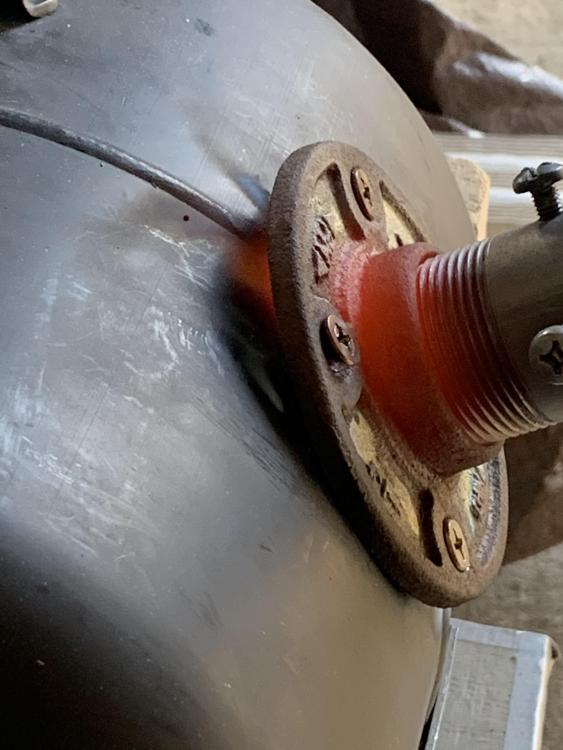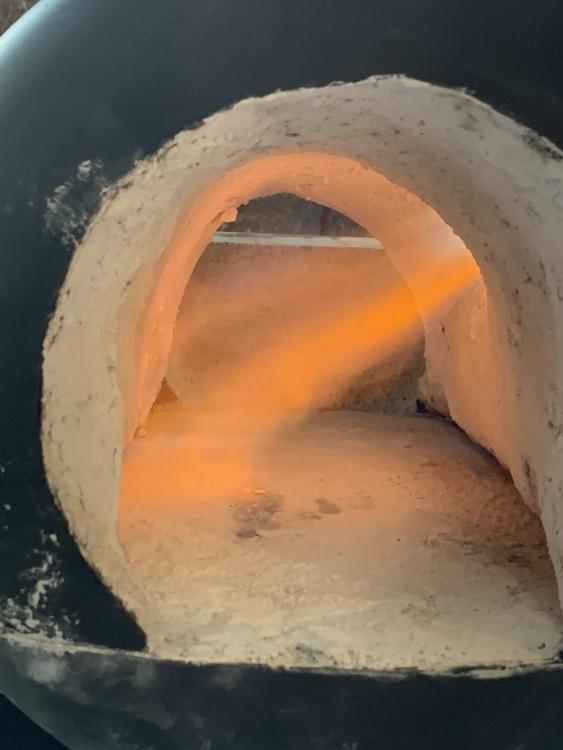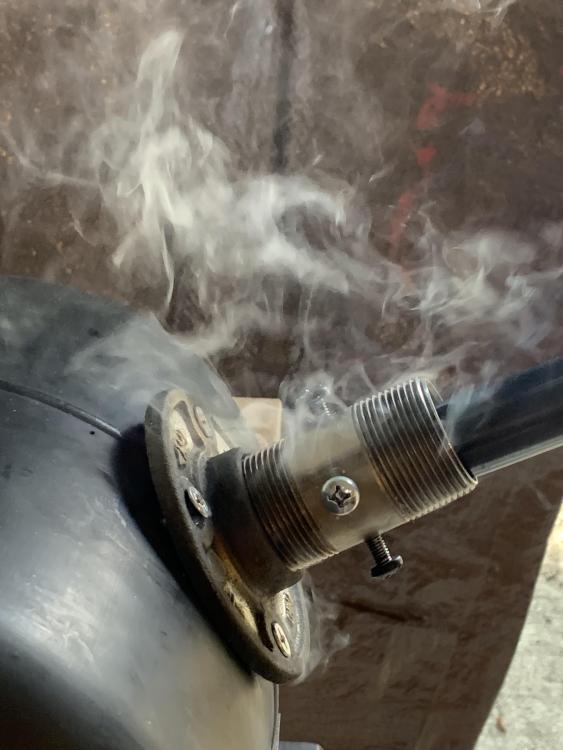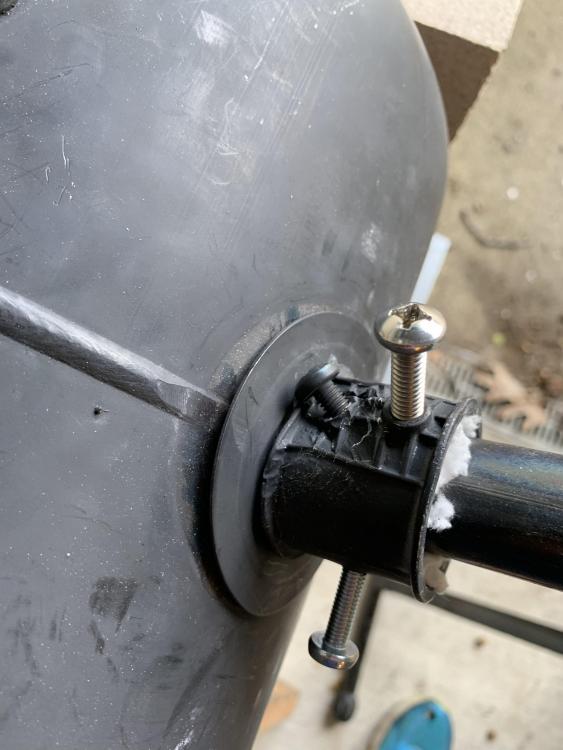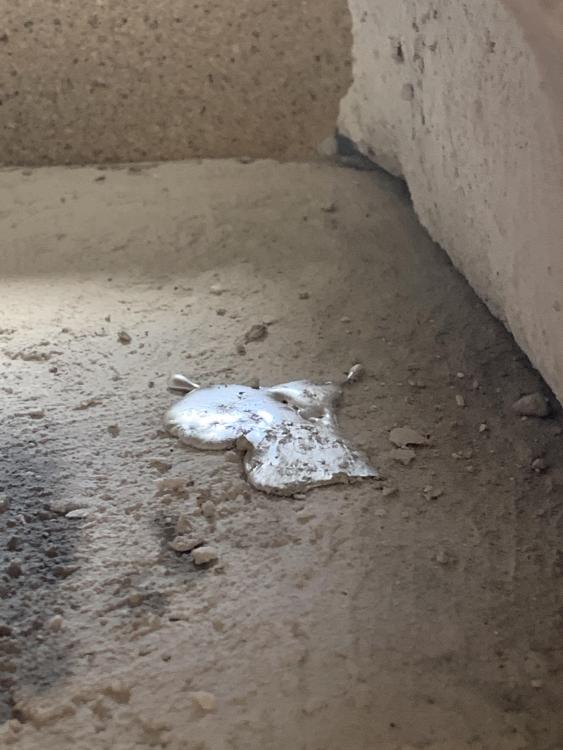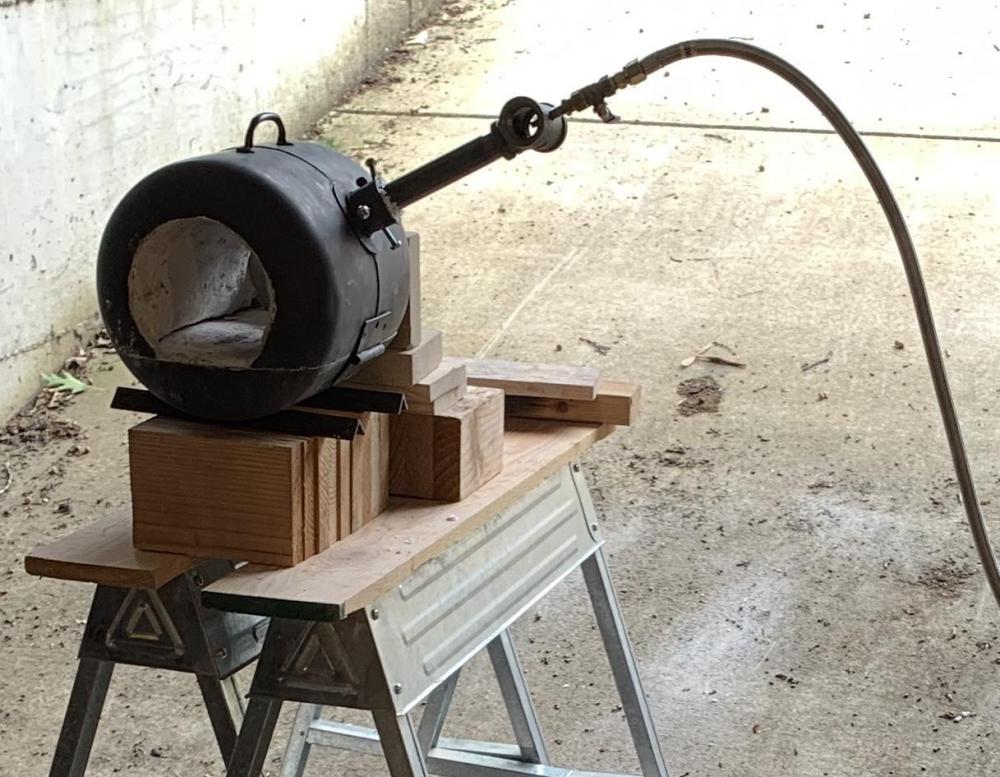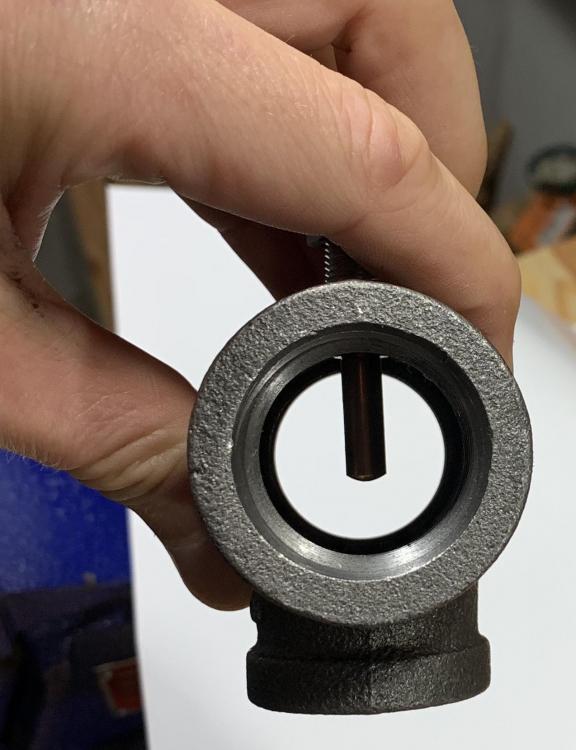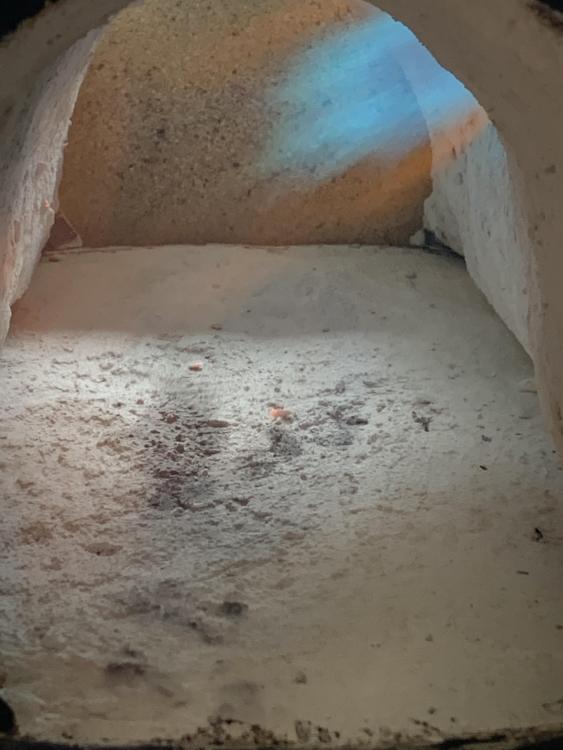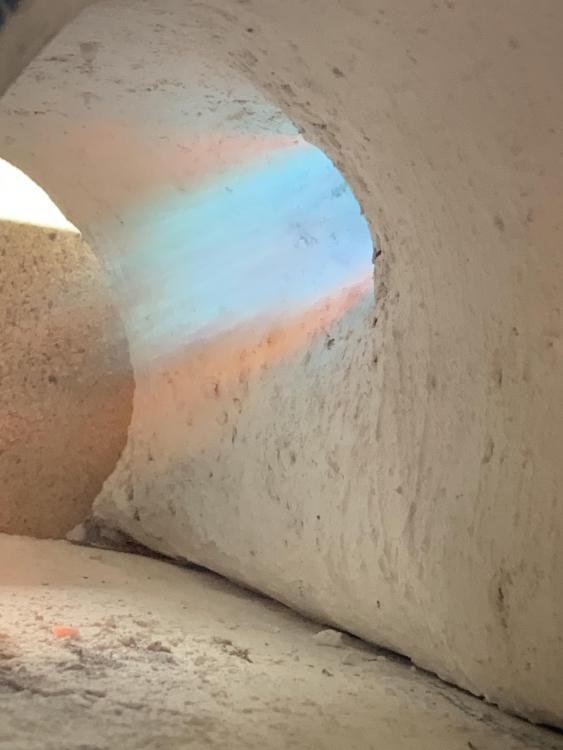
Erik F.
Members-
Posts
15 -
Joined
-
Last visited
Content Type
Profiles
Forums
Articles
Gallery
Downloads
Events
Everything posted by Erik F.
-
Sounds good. Thanks again, Frosty.
- 27 replies
-
- frosty t-burner
- burner
-
(and 2 more)
Tagged with:
-
Great! Thanks so much for the input, Frosty. I do have some leftover Plistix. If I understand you correctly, I just literally dip the burner (6” nipple) in a cup of the solution so that both the interior and exterior of the nipple get coated? On another note, I think I need to take care of two things before tinkering/tuning my burner further. Any advice is appreciated: 1. With the new burner sleeve, I was hoping that I could angle my burner higher up on the far wall of the interior (per earlier suggestions) but it looks like the flame is still angled right at the junction of the wall and floor. Unfortunately, the refractory along the roof of my burner port is too tight, preventing me from angling the burner higher up. Should I chip/grind away at this refractory and “re-cast” my port again so that I can improve the flame angle? Is it important enough? 2. I’m getting a decent amount of heat coming back into my new burner holder (specifically, the floor flange) - see pic. I do have a partial gap between the forge shell and the flange (b/c of the shell’s curved surface). (There’s also a small interior gap b/t the sleeve and the burner pipe.) I was thinking of putting some Inswool b/t the shell and the floor flange in hopes of decreasing the heat transfer. Thoughts? Thanks again, Erik
- 27 replies
-
- frosty t-burner
- burner
-
(and 2 more)
Tagged with:
-
Thanks!
- 27 replies
-
- frosty t-burner
- burner
-
(and 2 more)
Tagged with:
-
Okay, I finally got a new burner sleeve up and running! I went with the floor flange and short nipple - thanks so much for the suggestions. I just fired her up. Pics attached. Again, it’s a 3/4” T-burner with nothing on the tip (no thread protector, coupler, etc.). Tip is positioned *just* inside the shell of the forge. Pics were taken at 5 PSI. After a few minutes, I started getting some white smoke coming out of the burner sleeve. I shut it down out of precaution. The burner sleeve floor flange and nipple were both galvanized, but the nipple sat in vinegar overnight and the flange in vinegar for 2+ days. I’m assuming (hoping) the smoke isn’t burning galv??? I didn’t see any blue or green flames. There’s a small air gap in my burner sleeve, b/t the sleeve and burner, if maybe that helps with diagnosing the issue. The sleeve got some WD-40 after the vinegar bath, too. Once again, many thanks for any advice. -Erik
- 27 replies
-
- frosty t-burner
- burner
-
(and 2 more)
Tagged with:
-
You guys are awesome -- thanks for the ideas! I rigged something up to hold the burner this afternoon, but I think I need to beef it up with one of your ideas. Looks like it'll be back to the store for more stuff - I think they know my face by now. Frosty, I may have seen a trace of green flame right towards the end. Fortunately, it was only for a moment, right before shutdown. I'm counting my lucky stars. Very humbling.... Once again, thanks for the help. -Erik
- 27 replies
-
- frosty t-burner
- burner
-
(and 2 more)
Tagged with:
-
Son of a gun. You’re right. It’s advertised as “zinc plated steel“ but when I look in the fine print, the actual connector is zinc, and only the screws are zinc-plated steel. That’s so embarrassing. I’m an idiot.
- 27 replies
-
- frosty t-burner
- burner
-
(and 2 more)
Tagged with:
-
Well, dang. This is frustrating. I was testing the forge this afternoon. It had been going for a couple of minutes when I noticed that my burner holder looked funny. It was melting! There was a nice little puddle of molten stuff on the floor of the forge. The holder/sleeve is made out of a steel electrical conduit connector fixed to the tank with conduit reducing washers and conduit lock rings (idea taken from Zoeller "simple atmospheric gas forge" design). In retrospect, he used a 1-1/2" iron nipple for the sleeve -- I misread it and used an actual steel conduit connector, which is flimsier. At the risk of sounding stupid, was this the problem? *sigh* Now I have to figure out what to do. I did it this way because I don't have access to a welder. I'll now have to figure out some way to fix the burner to the tank. If anyone has any ideas, I'd be grateful. Pics of the gap b/t the burner and sleeve right in the beginning, followed by the aftermath. Right after firing up, before stuffing some Inswool in the gap: Aftermath: Flame before it melted
- 27 replies
-
- frosty t-burner
- burner
-
(and 2 more)
Tagged with:
-
Will do. Thanks, guys.
- 27 replies
-
- frosty t-burner
- burner
-
(and 2 more)
Tagged with:
-
Again, many thanks to you guys - your help is much appreciated. I'll tinker with the forge tomorrow and let you know if things aren't correctable. -Erik
- 27 replies
-
- frosty t-burner
- burner
-
(and 2 more)
Tagged with:
-
My apologies, Mike. I think I’m using the term “chimney effect” incorrectly. (I realize now that term means when residual heat moves up through the burner tube after shutdown?). What I was trying to refer to was the way in which hot air and small flames exit out through the gap b/t the burner and the burner sleeve, while the burner is running normally. Is this okay to have? The flame seemed better when the gap was plugged.
- 27 replies
-
- frosty t-burner
- burner
-
(and 2 more)
Tagged with:
-
Wow. Many thanks to the three of you for such a quick response. Much obliged! I’ll be sure to go slow and limit it to one variable at a time. Frosty: 1. I’d say the burner is loud but I wouldn’t call it screaming. Granted, my garage door is open, so maybe that decreases the noise level, but still, I wouldn’t have a hard time holding a conversation. What would the sound indicate about the burner? 2. The flame seemed about the same to me at 10psi. If it would be useful, I’d be happy to post some pics at different pressures. 3. I’ll work on orienting the burner away from the corner. I meant for it to come out more horizontally, but my burner port is a little off. But I think I have room to play with. 4. I’ll see if I can put the shutoff valve on the regulator side. I had planned on doing that, but the all-in-one regulator/hose/pressure meter doesn’t seem to let me. The junction b/t the hose and meter just spins, and the junction b/t the meter and regulator doesn’t budge. Maybe I just need to twist harder (b/t meter and regulator)? But I was concerned about breaking something. 5. One more question: I have a gap between my burner and my burner sleeve. I just stuffed some Inswool in the gap to reduce the chimney effect. Is this okay long-term, or do I need to come up with a better solution? Again, many, many thanks to all you folks. Your generosity with your knowledge and advice is so appreciated. Erik
- 27 replies
-
- frosty t-burner
- burner
-
(and 2 more)
Tagged with:
-
Hi everyone, Newbie here in Portland, Oregon. I just finished building my first forge and need some advice with tuning my Frosty T-burner. Here are the specs: Forge: Wayne Coe-style Freon forge, built exact to his instructions -- 1-2" Inswool, Kast-O-Lite refractory, Plistix Burner: Frosty T-burner, 3/4" nipple, 0.035 Tweco MIG contact tip, no flare (tried to build one into the refractory, but my guess is it's probably a little too wide) Other stuff: 1/4-turn ball valve at the burner, 3/8" propane hose, 0-30psi regulator The pics are taken with about 5psi of pressure. The burner nipple is situated so that it's barely inside the tank (and prob. 1.5" deep to the refractory). I was hoping I could get some advice about the flame -- shape, color, etc.. Please forgive my ignorance. I'm assuming I need to trim back the MIG tip a little -- it seems like that's the first recommendation from most of the posts I've read -- but I wanted to check with the gurus first before I went and did that. Forgive me if the pictures aren't helpful, or if others would be better. I'm happy to retake if necessary. Many thanks in advance, Erik
- 27 replies
-
- frosty t-burner
- burner
-
(and 2 more)
Tagged with:
-
9/16 - 5/8" O-1 is pretty standard for pole lathe hook tools. Anything smaller tends to not be stiff enough to turn wooden bowls with -- too much flex. I've made several tools with 5/8" round stock and it hasn't been too bad -- one only had to forge the last couple of inches. Thanks for the input!
-
I turn wooden bowls on a pole lathe (the old-fashioned, foot-powered treadle lathe). One uses special hook tools for the work (as opposed to gouges, which people use on electric lathes). The hook tools are quite difficult to find for sale -- most people forge their own. I've made a few using other people's equipment, but given social distancing and the need for a more-accessible way to make the tools, I'm putting together a small setup for home. Thanks for the help!
-
Hi all, I'm a beginner looking to get my first pair of tongs. I'll be working mostly with 5/8" round stock (about 12" long). I was going to get some V-bit tongs (either straight or bolt) but was curious about wolf jaw tongs as a possible do-it-all option. Any thoughts? Could wolf jaw tongs handle 5/8" round stock (both lengthwise and sideways), and if so, which size should I look for? I can't find much info out there. Or should I stick to straight v-bit or v-bit bolt tongs? Many thanks for any advice! Erik
